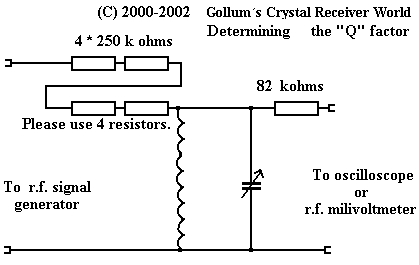Hints and Wrinkles
Determining the Q-factor of your resonant circuit.
Tips und Tricks
Bestimmung des Guetefaktors Ihres Schwingkreises.

When you own a r.f. generator, a frequency counter and an oscilloscope or a high impedance r.f. millivoltmeter, you will be able to determine the unloaded Q factor.
This will let you make improvements to your tuned circuit without just guessing.
Be ware that the method described here shows only approximate results since the load the r.f. generator and the oscilloscope put on the circuit will reduce the accuracy of the measurement somewhat. Also your ability to read the signal level on the face of your scope limits the accuracy. The use of a high impedance r.f. millivoltmeter offers better accuracy. The resonant circuit connected with the other components of your receiver offers lower Q results.
Connect the r.f. generator and the scope or millivoltmeter to the tuned circuit to be investigated as indicated in the schematic. Monitor the frequency of the generator with a frequency counter.
Example: B.C. Band (MW) resonant circuit.
Adjust the frequency of the generator to 1000 KHz (Frequency 1) Watch the r.f. voltage on the scope or millivoltmeter as you slowly adjust the variable capacitor of the tuned circuit to maximum.
Adjust the output voltage of the generator to exactly 1 volt per division on the scale of the face of your scope. Now change the frequency of the generator slowly until you have an indication of exactly 0.7 (0.707) volt per division.
Read the frequency on the counter (frequency 2).
Formulas:
Bandwidth = (Frequency 2 - frequency 1) * 2
1005 - 1000 = 5. 5 * 2 = 10 (KHz)
Q = frequency 1 / bandwitdth
1000 / 10 = 100
The tuned circuit Q (unloaded) is 100.
Check the Q of the tuned circuit at both ends of the band covered.
An unloaded Q of 250 already is a good value for a b.c. band crystal receiver. Connected to the circuitry lowers this value to maybe 150-175.
In Germany is a space of 9 KHz between two broadcast stations in use. This is good for a maximal AF bandwidth of 4.5 KHz. The result is an acceptable audio quality. (In other countries like USA is only a space of 5 KHz in use.) Is the Q factor to high, you can not realize a good AF quality.
In some construction projects there are unloaded Q factors of 500 mentioned. I am sceptical there whether that is reasonable. The Q is of course something lower when antenna, ground and phone is connected to the circuit.
Examples (- 3dB band width):
Q=100. AF bandwidth 5000 Hz
Q=125. AF bandwidth 4000 Hz
Q=151. AF bandwidth 3300 Hz
Q=192. AF bandwidth 2600 Hz !
Q=227. AF bandwidth 2200 Hz !!
Q=277. AF bandwidth 1800 Hz !!!
Q=416. AF bandwidth 1200 Hz !!!!
Q=500. NF-Bandbreite 1000 Hz !!!!!
Q=625. NF-Bandbreite 800 Hz !!!!!!
Q=714. NF-Bandbreite 700 Hz !!!!!!!
For a crystal receiver is a -3dB band widht lower 1800 Hz not reasonable. The music quality is unacceptable and the voice quality only poor.
Je bessser die Guete Ihres Schwingkreises, um so selektiver und empfindlicher ist Ihr Detektor-Empfaenger.
Wenn Sie einen HF-Mess-Sender, ein Frequenz-Zaehler und ein Oszilloskop oder ein hochohmiges HF-Voltmeter haben, koennen Sie die Leerlauf-Guete bestimmen.
Sie sind dadurch in der Lage, Verbesserungen vorzunehmen, ohne bei den Ergebnissen auf Vermutungen angewiesen zu sein.
Bedenken Sie bitte, dass die hier beschriebene Methode nur ungefaehre Werte liefert, denn der Messender und das Oszilloskop verschlechtern die Guete etwas durch die Belastung. Die Ablesegenauigkeit des Oszilloskops begrenzt ebenfalls das Messergebnis ein. Ein hochohmiges HF-Voltmeter liefert hier genauere Werte. Der Schwingkreis eingebaut im Geraet liefert natuerlich geringere Q-Werte.
Verbinden Sie den Mess-Sender und das Oszilloskop, wie im Bild gezeigt, mit dem Schwingkreis. Ueberwachen Sie die Frequenz des Mess-Senders mit einem Frequenz-Messer.
Beispiel: MW-Schwingkreis.
Stellen Sie 1000 KHz ein (Frequenz 1). Beobachten Sie mit dem Oszilloskop die entstehende HF-Spannung und drehen Sie den Drehkondensator auf Maximum.
Stellen Sie das Ausgangspotentiometer des Mess-Senders so ein, dass am Oszilloskop genau 1 Volt angezeigt wird. Aendern Sie nun die Frequenz, bis am Oszilloskop genau 0,7 V (0,707V) angezeigt werden.
Lesen Sie am Frequenzzaehler ab (Frequenz 2).
Beispiel: Frequenz 1: 1000 KHz. Frequenz 2: 1005 KHz.
Formeln:
Bandbreite = (Frequenz 2 - Frequenz 1)*2
1005-1000=5. 5*2=10
Q = Frequenz1 / Bandbreite
1000/10=100
Der Schwingkreis hat eine Leerlauf-Guete (unbelastet) von Q=100
Testen Sie die Schwingkreisguete am Bandanfang und Bandende.
Eine Leerlauf-Guete von Q=250 ist fuer einen MW-Detektor-Empfaenger schon ein guter Wert. Eingebaut im Empfaenger kann der Q-Wert dann wieder auf Q 150-175 abfallen, ausreichend fuer eine ertraegliche NF-Verstaendlichkeit.
In Deutschland betraegt der Abstand zwischen 2 Rundfunksendern 9 KHz. Es kann also maximal 4,5 KHz uebertragen werden. Daraus resultiert eine noch brauchbare NF-Qualitaet. In anderen Laendern (z.B. USA betraegt der Abstand zwischen 2 Rundfunksendern sogar nur 5 KHz). Wird die Guete des Schwingkreises zu hoch, ist eine brauchbare NF-Qualitaet nicht mehr realisierbar.
Es werden in Bauvorschlaegen manchmal Leerlaufgueten von ueber 500 versprochen. Ich bin da skeptisch, ob das sinnvoll ist. Natuerlich sind die mit Antenne und Erde und Kopfhoerer die belasteten Gueten etwas geringer.
Beispiele (-3 dB Bandbreite):
Q=100. NF-Bandbreite 5000 Hz
Q=125. NF-Bandbreite 4000 Hz
Q=151. NF-Bandbreite 3300 Hz
Q=192. NF-Bandbreite 2600 Hz !
Q=227. NF-Bandbreite 2200 Hz !!
Q=277. NF-Bandbreite 1800 Hz !!!
Q=416. NF-Bandbreite 1200 Hz !!!!
Q=500. NF-Bandbreite 1000 Hz !!!!!
Q=625. NF-Bandbreite 800 Hz !!!!!!
Q=714. NF-Bandbreite 700 Hz !!!!!!!
Fuer einen Detektoempfaenger sind - 3 dB Bandbreiten unter
1800 Hz weniger sinnvoll. Die Musikqualitaet wird unakzeptablel, die Sprachverstaendlichkeit
sehr schlecht.